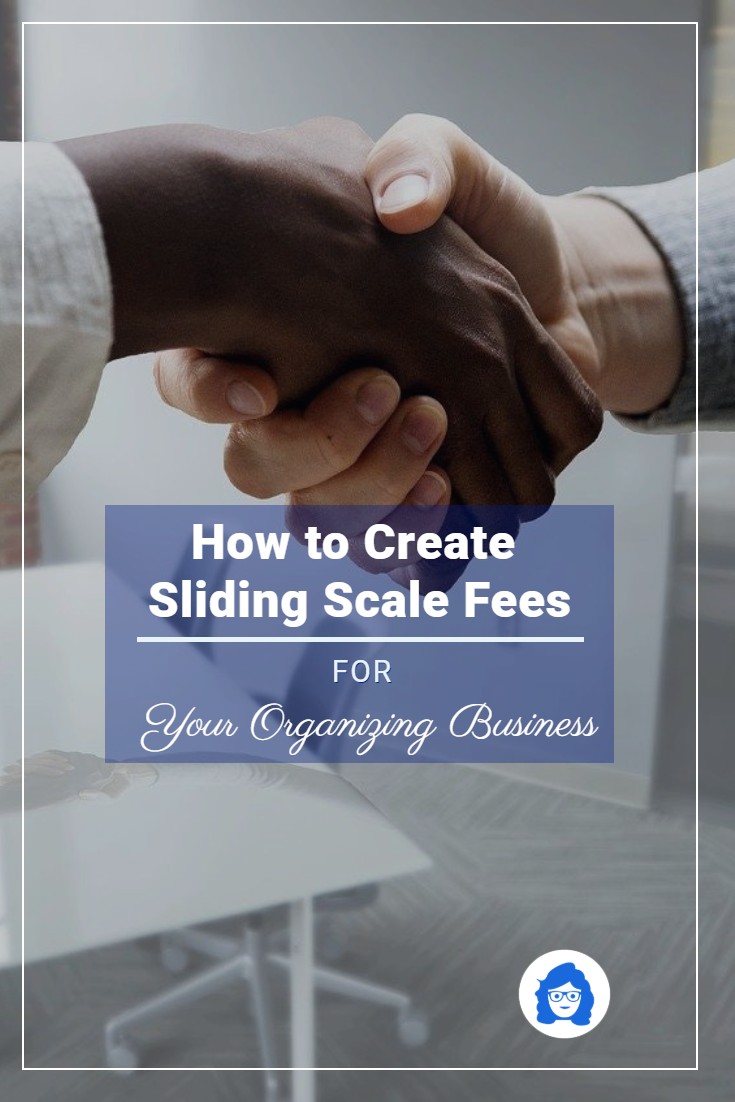How to Create Sliding Scale Fees for Your Organizing Business
This page may contain links to Amazon.com or other sites from which I may receive commission on purchases you make after clicking on such links. Read my full Disclosure Policy

One of the challenges I faced as a professional organizer was trying to help people who were truly in need of my services, but didn’t have the financial resources to budget for even a half-day session. I’ve recently blogged about alternatives to on-site services, including virtual organizing and coaching and the creation of digital products, and I know many of you are now offering these options, if you weren’t already. But for clients who really need a higher level of support, you may want to consider sliding scale fees.
Amanda Dodge has given this a lot of thought, and I’m pleased to share her insight with you.

As people across the United States take steps to make their neighborhoods more equitable racially, socially, and economically, some companies are introducing sliding scale fees to help historically oppressed residents. A sliding scale business model offers multiple payment tiers for customers who can only afford certain levels. It is similar to a pay-what-you-can model that makes your services more accessible to people who could otherwise never afford them.
The sliding scale business model is often used by therapists and health professionals who believe people shouldn’t need high income levels in order to have good mental health. We already know that there is a significant connection between organization and mental health, plus, your organizing services can empower local businesses to grow within your community.
If you have been looking for ways to offer more equitable services, consider a sliding scale business model. This guide will review the financial aspects of it along with the benefits to your brand.
Identify Who Gets Sliding Scale Prices (And Why)
Before you can develop a sliding scale business model, consider why you want to offer it and who would qualify for your services. A few customers that might benefit include:
- Business owners in low-income neighborhoods or zip codes
- Minority business owners or people from disadvantaged backgrounds
- Immigrant-run businesses and companies owned by indigenous peoples
- Small nonprofit organizations with minimal operating budgets.
- Community centers, churches, and other important pillars within local neighborhoods
This doesn’t mean that every nonprofit or community center gets a discount. However, promoting a sliding scale business makes your company more approachable and can start discussions with potential customers about appropriate payment amounts.
Along with answering the “why,” of your sliding scale model, you need to consider the “how.” Many people rely on the honor system when accepting lower fees, but you may ask for income statements, annual reports, and other materials to confirm that a person or company qualifies for a lower-tier invoice.
Develop An Appropriate Scale
The hardest part of adopting sliding scale fees is learning to set your rates at appropriate levels. If you experienced high levels of anxiety when developing your organizing business, then this may seem intimidating. These steps can help.
| Financial Steps for a Sliding Scale Model | Example |
Calculate your annual expenses.This includes your salary, marketing costs, materials needed, and operating expenses like office space or vehicle usage. This is the amount of income that your business needs. |
Expected salary: $60,000 Operating expenses: $15,000 Minimum profits needed: $75,000 |
Divide your monthly expenses by the average number of monthly customers.You can also track this number if your business is seasonal with busy months and slow months. The result is the average amount you need to bring in per customer. |
Minimum profits needed: $75,000 Minimum profits needed (per month): $6,250 Average number of customers per month: 25 Average order value per month: $250 ($50/hr) |
Track the average costs for organizing services in your area.This will help you understand what high-end and low-end services look like. |
Company A: $35/hr Company B: $45/hr Company C: $50/hr Company D: $75/hr Company E: $100/hr |
Adjust your prices around these averages to create a sliding scale.You can charge toward the low-end side (and even dip below it) for your sliding scale but won’t want to price yourself out of the high-end market. |
New Prices:Standard: $80/hr |
You may decide to increase your prices as you research other organizers in your area. However, you don’t want to reach a level where your customers aren’t willing to pay. Additionally, you may need to make some adjustments to your sliding scale prices over time.
Track Sliding Scale Clients for Your Taxes
When you accept clients through your sliding-scale system, track their rates compared to the normal levels that you would normally charge for your services. Your sliding scale rate may qualify as offering charitable services, which could help you with tax deductions. This is because the time you lose by taking on low-income clients could be spent growing your client-base with high-paying customers.
Note: if you are unsure about the tax laws in your area, talk to an accountant before you debut your sliding scale system. They may be able to help you track your lost income and help you set prices.
Use Your Sliding Scale as a Marketing Tool
One of the main concerns that business professionals have when debuting a sliding-scale system is that their companies will get overwhelmed with low-level clients. However, this program can be used as a valuable marketing tool.
According to a 2018 survey by Accenture, 63% of customers buy goods and services from companies that reflect their own beliefs. The same amount want companies to take stands on social, cultural, environmental, and political issues. You are more likely to win over new customers if you offer a sliding scale and use your equitable actions as a selling point.
Additionally, you can put processes in place to limit the number of lower-level clients you accept. Consider capping the amount of new lower-level clients each month or creating a waiting list to offer your services during a less busy time. This frees up your schedule to take on higher-paying clients who can help you maintain a healthy financial balance.
A Sliding Scale Does Not Mean Accepting Less for What Your Services Are Worth
A sliding scale model is meant to help you offer equitable services to low-income customers who need your help. You are supporting your community and building up companies that would otherwise struggle to afford your services.
This sliding scale does not mean you accept less from every customer. It does not mean that you value yourself less and give everyone a discount.
You have the opportunity to play an important role in your local economy and help those who need your organizing skills – regardless of what they can pay. Accepting less may be a small inconvenience for you in the short run, but the value you provide will help your neighborhood exponentially.
Streamline Your Business and Focus on Serving Clients
Implementing a sliding scale fee structure can help you reach a wider range of clients and make a meaningful impact. But managing a business with flexible pricing requires time and attention. With my Website Care Plans, you can offload the routine website maintenance tasks—like backups and updates—so you can focus on building relationships and serving your clients without distraction.





This is an interesting topic! I don’t offer a sliding scale, but I have done some work pro-bono for people in need. I also offer packages through which people can save money. Something to think about for sure:)
I don’t think I’ve heard anyone talk about this with organizing services. I look forward to seeing what others think of the idea.
Interesting article, thanks! I have an informal sliding scale which means I haven’t been advertising it. I always have one client who pays significantly less than other clients based on need. When that client’s project is done, I’m open for taking on another client like that, again based on need. After reading this, I’m thinking letting people know this on my pricing page could be a smart business move. The beauty of running your own business!
Good idea! And you find too many people are asking for a lower rate, you can take it off again.
That’s really awesome of you! (And I think it’s something people do often.) Getting the marketing in-line and documenting both your marketing materials and “lost income” for taxes can help you offer these lower rates without necessarily losing money. Good luck with developing a plan!
Really great information here. I don’t currently offer a sliding scale but will certainly consider it going forward.
Like Seana, I offer virtual organizing packages that benefit the client. The larger the package, the lower the hourly rate. I also created a temporary reduced “COVID-19” rate for clients that are struggling financially due to lost income or job. Also, I have a Client Loyalty Program that I track for my clients. It’s an ongoing program. The more VO sessions they have, the more credit dollars they receive.
I love how well thought out Amanda’s ideas are around calculating and implementing a sliding scale. She made an interesting point about the “charity” rates, possibly being a tax-deduction. I hadn’t thought of that and will discuss it with my accountant.
Thanks for the kind words! I get really nervous for friends and family when they offer me freebies. A friend recently offered me a free service because of a referral I sent to them, and I kept asking if they were documenting the expense for marketing or client gifts. I just don’t want them to lose money!
Interesting post. I did this early on for young adults in small apartments and new business startups. It worked pretty well. I like your suggestion of requiring certain financial reports to prove that they are in need. Thanks for sharing.
Thank you! That’s awesome of you to offer help for young adults starting out. Depending on the business, some people might even be able to set up a Google form on their websites for clients to apply for a lower rate — almost like a grant program.
I’ve always provided a sliding scale for students, seniors, and anyone who is unemployed. I think to myself, “But there for the grace of God go I.” My goal is to be as helpful as I can and without turning a client away because of their inability to pay. I feel good about it in the end.
I love that you run your business so ethically and with a focus on helping others. I’m sure your customers appreciate the help as they try to physically and mentally get organized and on the right track.
Great post! It’s good to think about your taxes when creating this type of fee structure. I do something similar for those clients that need a lot of work done. Thanks for sharing!
Thank you! I am not a tax expert by any stretch. (The opposite: do not take tax advice from me please.) But an accounting expert should be able to help you better understand your options and make sure you get enough bang for your buck.
I’ve never considered a sliding scale for my fee. We do do some pro-bono work for a local charity and I am working on a product that people can purchase for way less than our in-person organizing rates.